This soft and fluffy Ancient Grain Sandwich Bread is made with KAMUT flour which adds a delicious buttery flavor.
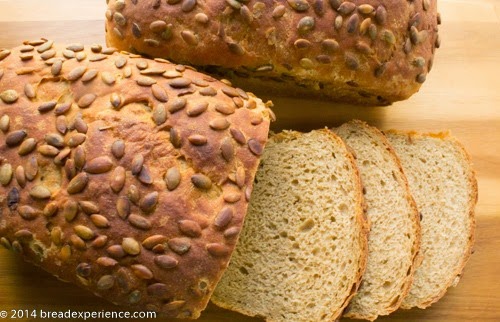
If you like soft and fluffy sandwich bread, but prefer a flavorful and nutritious loaf to one that’s bland and full of empty calories, you might enjoy this Sorghum, Kamut, and Pumpkin Seed Bread.
It’s made with an overnight levain of sorghum flour and Kamut sourdough and an overnight poolish made of Kamut white and whole grain flours.
I’ve been working with Khorasan wheat (which is trademarked KAMUT) for a while, and I just love this ancient wheat. It adds a beautiful golden color to loaves and is a dream to work with. KAMUT’s bread-baking qualities are similar to modern wheat, however, it contains about 20% – 40% more protein than modern varieties of wheat. As a result, it absorbs more water.
What is Sorghum?
Sorghum is an ancient grass that is rich in antioxidants and contains the same types of vitamins and minerals as those found in corn. Sorghum is gluten-free and it doesn’t retain moisture very well. So you need to precook the flour to hydrate it sufficiently.
Scaling the formula to suit my needs
The original formula for this bread is from the San Francisco Baking Institute. I’ve been thinking about making this bread for months but kept shying away from it because I wasn’t sure if I could scale down the formula properly.
I needed a challenge this weekend so I decided to try my hand at scaling the formula down to a manageable size. I reduced the number of loaves and changed the percentages of the flours used. I didn’t set out to change the flour, but it happened because I misread my notes. The dough still had a greater proportion of white Kamut so it worked out fine.
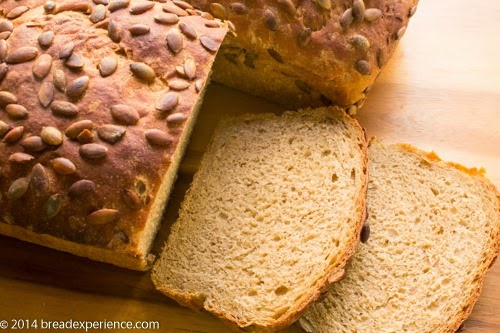
This loaf has a soft, melt-in-your-mouth texture, and it is good for you. I can’t quite put my finger on the flavor. Sometimes it tastes a little bit tangy due to the levain and other times, it tastes a little bit nutty. It’s a tender and flavorful loaf.
Ancient Grain Sandwich Bread
Makes: 2 large loaves or 3 medium loaves
Adapted from: Sorghum, Kamut & Pumpkin Seed Loaf by Mac McConnell of the San Francisco Baking Institute
I recommend that you weigh the ingredients for this dough.
KAMUT Poolish
| Ingredient | Weight |
| White KAMUT flour | 92 grams |
| Whole Grain KAMUT flour | 31 grams |
| Water, warm | 123 grams |
| Salt, fine sea | pinch |
| Yeast, instant dry | pinch |
Sorghum Liquid Levain
| Ingredient | Weight |
| Sorghum flour | 155 grams |
| Water, boiling | 350 grams* |
| KAMUT liquid starter | 20 grams |
* The hydration will vary with the quality and moisture content of the flour you use.I used Bob’s Red Mill sorghum flour. It was absorbent so I ended up adding over double the amount of water called for in the original recipe.Prepare the KAMUT Poolish and Sorghum Levain the day before you plan to make this bread.
Mix the ingredients for the poolish until well incorporated. The D.D.T. (desired dough temperature) is 70 degrees F.
The starch in the sorghum flour has to be gelled with boiling water before adding the sourdough. Pour boiling water over the sorghum flour. Mix to incorporate; cool to 70 degrees F. before adding the sourdough seed to the mixture.
Allow the poolish and the levain to ferment for 12 –14 hours at room temperature (65 – 70 degrees F.)
|
KAMUT Poolish |
Sorghum Liquid Levain |
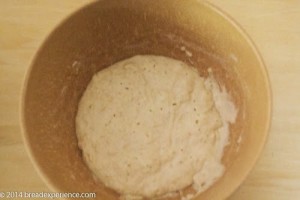 |
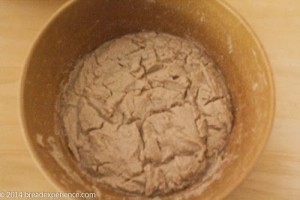 |
Final Dough
| Ingredient | Weight |
| White KAMUT flour | 610 grams |
| Whole Grain KAMUT flour | 206 grams |
| Water, lukewarm | 530 grams |
| Yeast, instant dry | 5 grams |
| Salt, fine sea | 20 grams |
| Molasses | 70 grams |
| Honey | 20 grams |
| Butter, softened | 58 grams |
| Vital wheat gluten | 7 grams |
| Malt extract | 7 grams |
| KAMUT poolish | All |
| Sorghum liquid levain | All |
Making the final dough
The next day (or after 12 – 14 hours), place the white and whole grain KAMUT flours, water, yeast, salt, malt, honey, molasses, vital wheat gluten, KAMUT poolish, and butter in the bowl of a stand mixer.
Hold back some of the water to determine how much liquid your flour will absorb. Mix on low speed to obtain a strong gluten development. Add more water if necessary.
Add in the sorghum levain and mix until it is thoroughly incorporated into the dough. The dough will be slightly sticky.
Bulk Fermentation
Place the dough in a greased bowl and give it one fold in the container.
Cover the dough with plastic wrap and let it bulk ferment for 2 – 2.5 hours at room temperature.
For the first 1.5 hours, perform a stretch and fold every 30 minutes (for a total of 3 folds).
To do the stretch and folds, remove the dough from the bowl to a floured surface and stretch and fold each edge over the center of the dough on all sides. Place the dough back in the bowl and recover with plastic wrap. Continue the bulk fermentation. After the 3rd fold, let the dough rest for the final hour, until it is doubled in bulk.
Divide & Shape the Loaves
Transfer the dough to a floured counter. Divide the dough into two or three equal pieces.
Shape them lightly into rounds and let them rest on your work surface or a wooden board for 20 – 30 minutes.
Degas the dough slightly. Shape the loaves into tight cylinders and place them seam-side down into greased and floured loaf pans. I made two large loaves using 9” x 5” loaf pans.
Spritz the top of the loaves with water and sprinkle them with pumpkin seeds. Press down lightly on the seeds and spritz with more water if necessary to hold the seeds in place.
Final Proof and Baking the Loaves
Allow the loaves to proof for 1 – 1.5 hours at 75 degrees F.
Preheat the oven to 375 degrees F. Bake the loaves for 30 to 35 minutes or until completely done. If the loaves start to brown too fast before they are baked through, tent them with foil.
Remove the loaves to a wire rack to cool completely before slicing and serving.
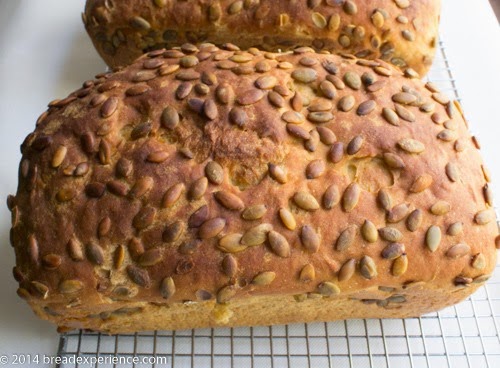
This bread is so good! It is worth the effort. However, keep in mind that most of the time is spent fermenting the dough.
Happy Baking!
Cathy
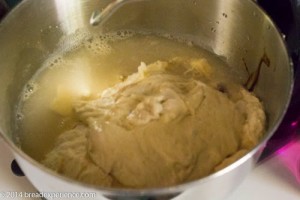
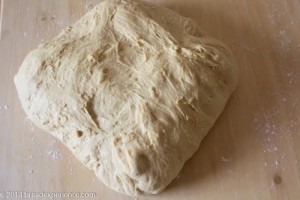
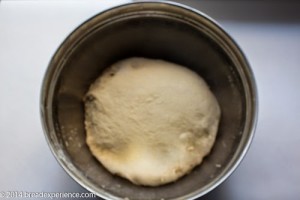
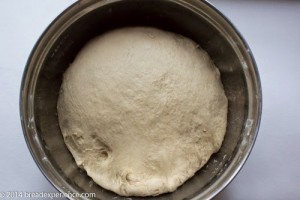
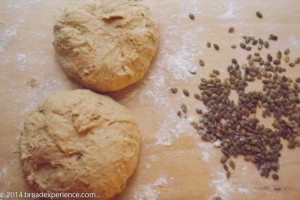
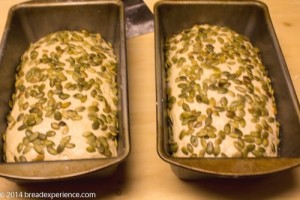
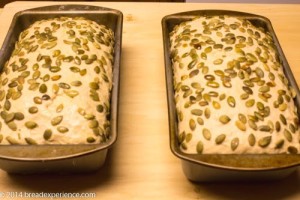
Colleen W. says
This looks great! does the sorghum levain have to be made with sorghum flour? I don’t have sorghum on hand, but I have quite a few other ancient grains. I do have millet, would that or buckwheat work?
Thank you,
Cathy says
I haven’t tried millet or buckwheat in this recipe, but it would be an interesting experiment. Although the buckwheat might give the bread a bit of a spongy texture. This happened to me recently. But with this bread there is enough white KAMUT to offset the flavor. If you do try it, let me know how it goes.
Colleen says
Is the Kamut liquid starter the same thing as sourdough seed? Is this simply a kamut based sourdough? Also is the vital wheat gluten necessary? I’m trying to keep my bread low gluten because my mom is sensitive to gluten. That’s why I’m sprouting my Kamut beforehand.
Thank you for the info about the buckwheat.
Cathy says
The Kamut liquid starter is the same thing as a sourdough starter. You just need 20 grams.
This sourdough spelt bread might be a better option. https://www.breadexperience.com/whole-grain-sourdough-spelt-oatmeal-bread/
I’ve made it with einkorn and spelt and it should work for sprouted Kamut as long as you don’t let the grains sprout too long. You can omit the oats, if desired, and adjust the hydration. Keep in mind that Kamut flour typically requires more hydration.
Hope this helps.